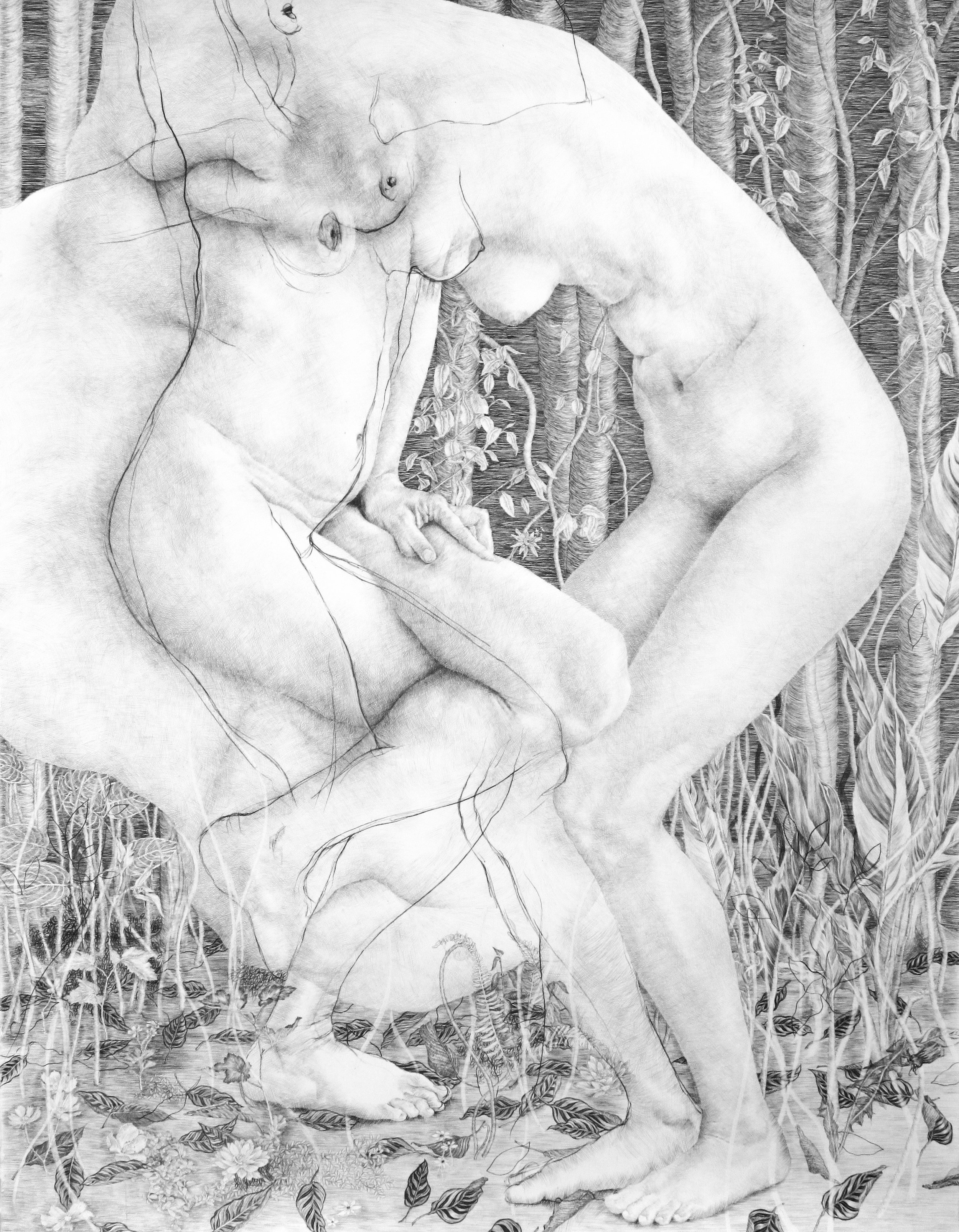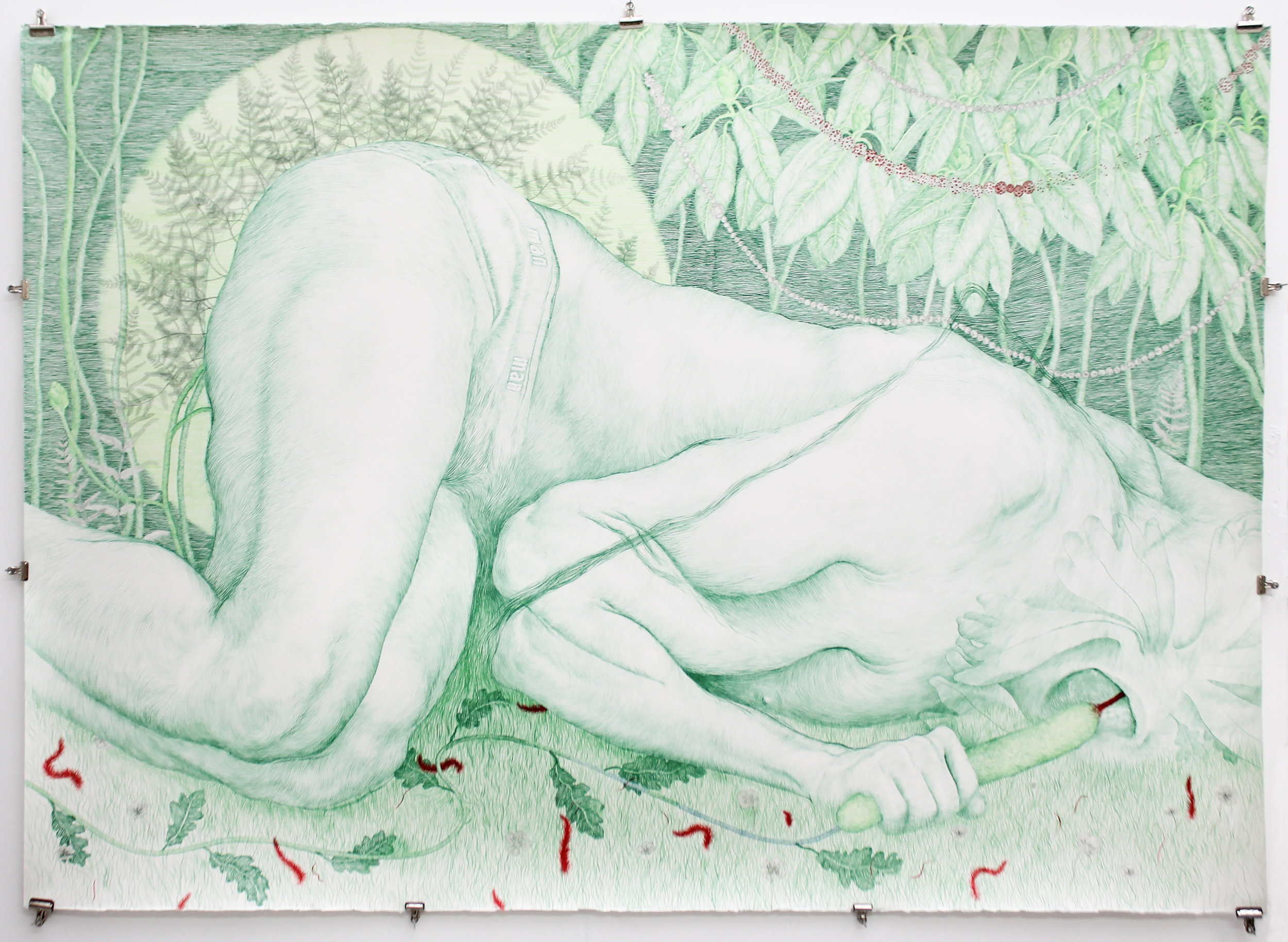Sara Anstis was raised on a small island off the Canadian west coast and draws and lives wherever she finds good light. Her investigations take place at various sites, and with different social groups. Discomfort and bodily experiences cause her work to evolve through drawings and installations that question the image of the body and the desiring look.
She is currently completing the postgraduate drawing year at the Royal Drawing School in London.

You were born in Sweden, grew up on an island off the Canadian coast, and now live in London studying at The Royal Drawing School. How has living in these very different environments influenced your artistic approach or outlook?
I grew up on Salt Spring Island, which is a small and very creative community. I haven’t been back there since my father died, and in my mind, it remains the idyllic space I roamed barefoot as a teenager. I think it has been the most important and formative environment for me artistically.

Although much of your work is rendered in graphite charcoal, your more recent work has adopted the use of color as well as elements of further abstraction. Tell us about this development. What inspired you to diverge in style as well as palette?
I change the medium I work with to fit the subject of my work. Right now, I am looking at male bodies performing survival tasks in the contested location of “wilderness” and trying to figure out my attraction to survivalism reality television shows. Using color became essential as I realized that color forms a large part of this attraction; the surrounding greens of plants is what gives these bodies a soft bed to lie on. In Bluets the author, Maggie Nelson, tries to map her fixation with the color blue and its connection to her sexuality, her melancholy, and the female gaze, through poetic writing. Through drawing, I am attempting something similar, to speak of how these notions merge with my greens. I’m also putting together a publication with writings from seven artists, which is a re-imagining of a classic wilderness survival guide.
The figures in your drawings are often layered, overlapped, or twisted, transforming into different modes of being. Can you tell us about the highly psychological effect these bodily distortions create in your compositions?
The outlines of our bodies are deceptive. Skin is porous and many foreign organisms live inside us. In Vibrant Matter, Jane Bennett talks about skin as “a superficial indication of where an organism ends and its environment begins” – this is something I think about in relation to my figures melting into each other and sometimes their surroundings. Drawing other bodies, from life and from photographs, also has to do with merging and becoming part of; in the act of drawing, something is exchanged, which changes both the drawer and the observed subject. I often draw the body of the lover, whose skin is a surface on which I project existential questions and whose presence enhances the horrors of scopophilia, abjection, and domesticity.
Your artist statement states that your work, “question[s] the image of the body.”
Can you discuss this in relation to your most recent drawings?
At the moment, I’m transfixed by images of men alone in nature, particularly in a reality
television about survivalism called Alone. When I first saw an episode, I wasn’t sure why

I was so attracted to the images it portrayed, so I decided to unpack this attraction. I think it concerns the gender politics around the figure in the landscape, typically a romanticized man or a man in the Romantic tradition seeking out natura naturans, and the eroticism and vulnerability of this figure interlaced with greenery. It also has to do with envy, as
I’m very comfortable with solitude and spending a lot of time outside, and with my connection to the Canadian west coast, which is where the series is filmed.
In my recent drawings, I’ve been getting my ideas from survival courses I’ve taken where we might butcher an animal carcass or build fires with limited tools. My position as an outsider visiting survival groups allows me to examine the contradictions inherent in their activities and the unethical nature of my desire. I want to depict masculinity from a desiring female standpoint, which I find a lack of in the images I’m exposed to.
What has your experience been like working in a creative environment at The Royal Drawing School? Tell us a bit about this program and what it was that drew you to it.
I’m really enjoying it. It’s a one-year postgraduate program during which we draw from observation while developing our studio practices. Often, we are in the life room, but also in Kew Gardens drawing plants, or in different museums in London studying paintings, drawings, and prints. The sensation of being watched while I draw in public places is something I’ve gradually become accustomed to this year. I applied because I wanted to develop my visual language after I finished my MFA in Sweden, as I felt that I knew my work, but I’d lost touch with my materials. We’re working towards three exhibitions that will happen this coming winter at the drawing school in Shoreditch, at Space
Studios in Hackney, and at Christie’s London.

Is there any specific artist whose work has helped shape your aesthetic? Are there other artists currently working primarily in drawing that inspire you?
I couldn’t say there’s one artist in particular, but right now I am absorbed by Carol Rama, Bronzino, and the 15th century Italian painter Lorenzo Monaco. In terms of drawing artists, my friend Behjat Omer Abdulla never ceases to amaze me. His projects have an incredible sensitivity in how they approach difficult narratives. I saw a talk given by
Catherine Anyango Grünewald recently, and her tactile and painful relationship with
graphite, paper, and erasers really resonated with me. Others include Vanna Bowles,
Alphachanneling, and David Shrigley,
If you could visit any place in the world, where would you go next?
My studio.













